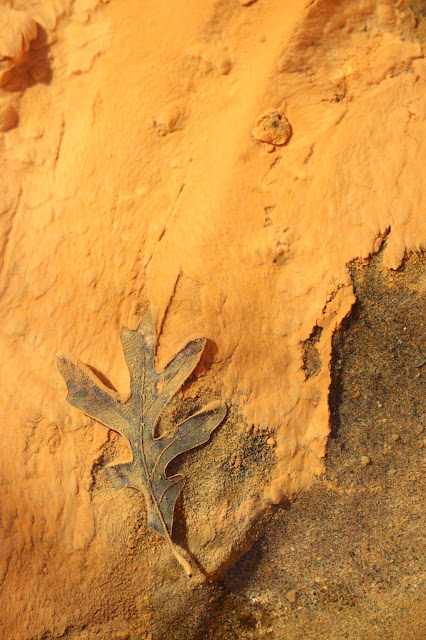Why I Love Blacklight
Whenever I bring home a new batch of fossils, I pull out my UV rock
lamp. Why? Some fossils glow in the dark, but not in a uniform way.
Variations in the mineral composition make for a variety of colors, even
when the specimen seems fairly uniform in color in daylight. This can
make small, hidden details really stand out.
Case in point: This afternoon I was putting away some petrified wood I'd collected awhile back. I pulled out my black light to examine them because some of the wood from this site shows a rainbow of color under UV. This one particular piece was mostly orange under UV, though in camera the hues look different. What really got my attention, however, were a few really vibrant spots on one side. Insect traces! The petrified wood chip is only about 8 cm long. Even with a magnifier, some of the small details are hard to spot. I never would have spotted them in daylight, but they were super bright with the UV.
Another box I was sorting through this week contained impressions of brachiopods and trilobites in plain, white limestone. It can be hard to see the contours in the matrix, but they show up much differently under the UV.
Finally, UV light can be used to identify fossil mollusks whose patterns have bleached away. About 60% of fossil shells fluoresce and some species have been described based on the residual patterns made visible under ultraviolet light.
Note: To photograph these, I used a Convoy UV LED flashlight. I set my camera on a tripod for a 4 second exposure at f/22, with ISO set to 1600. I had my DSLR's white balance set for daylight.
Case in point: This afternoon I was putting away some petrified wood I'd collected awhile back. I pulled out my black light to examine them because some of the wood from this site shows a rainbow of color under UV. This one particular piece was mostly orange under UV, though in camera the hues look different. What really got my attention, however, were a few really vibrant spots on one side. Insect traces! The petrified wood chip is only about 8 cm long. Even with a magnifier, some of the small details are hard to spot. I never would have spotted them in daylight, but they were super bright with the UV.
Another box I was sorting through this week contained impressions of brachiopods and trilobites in plain, white limestone. It can be hard to see the contours in the matrix, but they show up much differently under the UV.
Finally, UV light can be used to identify fossil mollusks whose patterns have bleached away. About 60% of fossil shells fluoresce and some species have been described based on the residual patterns made visible under ultraviolet light.
Note: To photograph these, I used a Convoy UV LED flashlight. I set my camera on a tripod for a 4 second exposure at f/22, with ISO set to 1600. I had my DSLR's white balance set for daylight.







Comments
Post a Comment